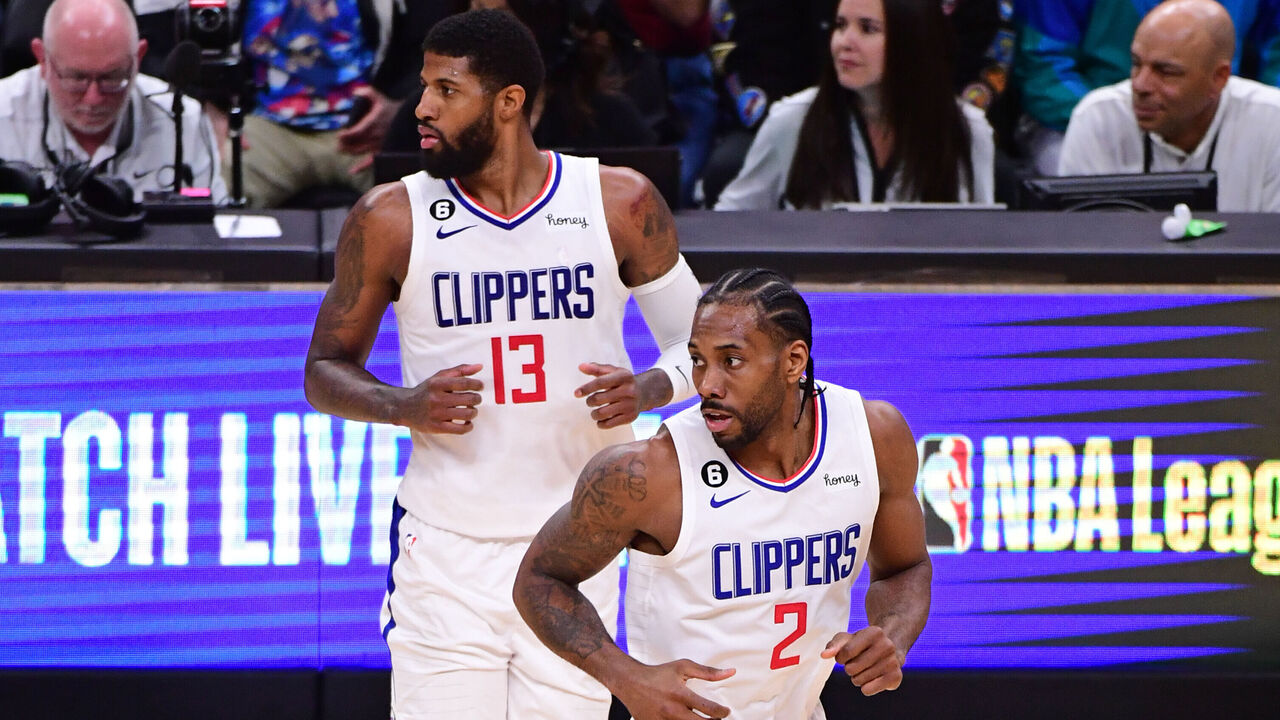The Clippers played themselves
It’s been easy to clown the Los Angeles Clippers over the last half decade as they’ve stumbled from one ill-timed injury and deflating postseason exit to the next, backed themselves into one team-building corner after another, and produced only three playoff series wins after uniting Kawhi Leonard and Paul George in July 2019. But one thing you could never question about the organization was its ambition.
The front office shelled out long-term assets for present-day stars and kept pushing to surround those stars with complementary talent. Owner Steve Ballmer spent and spent and spent, running nine-figure luxury-tax bills and at one point forking over a third of a billion dollars for his roster alone. He also broke ground on a $2-billion arena in Inglewood that’s set to open next season, a new home to help give the Clippers a distinct sense of identity and place after spending 25 years essentially crashing on the Lakers’ couch.
The front-office and ownership mandates didn’t always translate to on-court success, and there’s no denying the Leonard-George era was a disappointment, especially given everything that was sacrificed to breathe it into existence. Both of them struggled to stay healthy, and the team’s chemistry was never calibrated quite right. It certainly wasn’t for lack of trying, though.
Letting George walk for nothing in free agency, five years after trading away Shai Gilgeous-Alexander and control of seven first-round picks to get him, marks a dramatic shift in attitude.
It’s understandable, after myriad letdowns, why L.A. wouldn’t want to pay George max money through his age-38 season. But haggling over a fourth year in the deal – which is reportedly what caused the breakdown in negotiations that led to George signing in Philadelphia – showed a willful ignorance of how far down the road the Clippers already were, and the lack of better alternatives.
George is still amazing, coming off an All-Star season (his ninth) in which he averaged 23-5-4 on 61% true shooting, which included hitting 41% from deep on nearly eight attempts per game, all while continuing to play high-level defense. And it’s not like relinquishing George afforded the Clippers the cap space to sign a remotely comparable replacement; it merely gave them access to the non-taxpayer mid-level exception, which they used to sign Derrick Jones Jr., a solid defense-oriented role player who leaves the starting lineup with almost no spacing.

Ironically, all the spending Ballmer did over the last five years, all the spending that resulted in those three measly series wins, was a big part of the impetus for the rest of the league’s owners pushing for the draconian “second-apron” luxury-tax penalties that surely played a part in dissuading L.A. from giving George the deal he sought.
Being above that second apron would’ve posed significant team-building challenges. In that scenario, the Clippers wouldn’t have had access to the MLE, wouldn’t have been able to aggregate salaries or take back a penny more than they sent out in trades, and could’ve ultimately had their 2032 first-round draft pick frozen, all while Ballmer footed sky-high bills with compounding repeater tax penalties. And that still would’ve been vastly preferable to the route they chose, which seems destined to consign them to irrelevance.
The Clippers don’t control their own first-round pick in any of the next five drafts, thanks to the last remnants of the George trade and the deal that brought in James Harden last season. They have almost no young talent to build with; their youngest rotation players as of now are 27-year-olds Ivica Zubac, Amir Coffey, and Jones. They’ve already committed to Leonard for the next three years, and it’s not like they project to have significant cap flexibility at any point over the life of that deal. They re-upped with Harden for at least one more of his mid-30s seasons. There’s no potential pivot staring them in the face.
This is as much of a win-now team as there is in the league, and the Clips are about to open their glitzy new arena. So naturally they … balked at including a fourth year for the top-20ish player they once paid out the nose to acquire? Why was that the line in the sand?
The Clippers convinced Leonard to accept a shorter-term deal at a slight discount relative to his max, and acted as though George owed them those same concessions, as if there wasn’t a contending team with max cap space that would be more than happy to give him every cent he was eligible to receive. They overplayed their hand and it led to disaster, no matter how the organization tried to spin things in its bizarre statement about George’s departure.
You can argue that running it back would’ve felt futile in its own right, given the Clippers’ longstanding on-court foibles and the ages and health risks of their core trio. But at least they would’ve been a good team with an outside shot at achieving greatness if things finally broke right. They could’ve sold themselves and their fan base on the possibility of recapturing the magic that saw them go 26-5 in December and January last season.
Without George, though, they simply go from good to mediocre or worse. If Leonard’s knees continue to fail him, this has a chance to turn into a 2010s Nets-level catastrophe. As my astute colleague Joseph Casciaro put it, L.A. is willingly taking a huge step back despite being one of the teams that can least afford to do so.
Even amid some embarrassing flameouts over the last few years, these Clippers have operated in a way that set them apart from the bumbling regimes that governed the team in years prior. But the way they handled this George situation feels like a throwback to a different era. It ends a disappointing chapter in Clippers history with a classic Clippers fumble.


